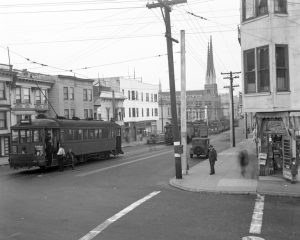Noe Valley as a whole is named for José de Jesús Noé, the last Mexican mayor of Yerba Buena, as San Francisco was known until the 1840s. Awarded by the governor, Noé’s 4,443-acre Rancho San Miguel spread from The Castro in the north nearly to the Daly City border to the south. The land remained Noé’s after the Mexican-American war ended in 1848, and he began selling off bits and pieces until his death 14 years later.
A large piece of Rancho San Miguel that included Noe Valley was sold for $285,000 in 1854 to John Meirs Horner, who began laying out and naming streets. Upper Noe’s Duncan Street is thought to be named for Chapman Duncan, one of Horner’s friends and a fellow Mormon. Residents still see this area identified as Horner’s Addition on their property tax bill.
German and Irish immigrants moved into Noe Valley and neighborhoods south during the 1800s and much of Noe Valley was built at the end of that century. Many examples of Victorian and Edwardian residential architecture remain for which San Francisco is famous.
By the 1880s, the northern end of the valley along 24th Street was developing quickly, especially after the addition of a cable car to downtown. In contrast, the more remote upper end of of the valley (away from downtown) was slow to attract residents. Dairy farms, such as Mitchell’s Dairy, dominated the landscape. (the family’s Mitchell’s Ice Cream shop remains as a popular destination). Church Street grew as the main commercial corridor, offering goods and services and eventually a streetcar to downtown in 1917.
Upper Noe Valley gradually filled in with fine housing stock full of working class families. Upper Noe Valley is home to the grandest mark made by the Catholics among them: St. Paul’s Church. The church, completed in 1911, took 14 years to build, and much of the labor was done by parishioners, many of whom were builders by trade, according to local lore. Built in American Gothic Revival style, the church has been the backdrop for the movie Sister Act, and has appeared in two episodes of the Streets of San Francisco, a popular television drama in the 1970s.
Quiet as it is, the south end of Noe Valley is not without its explosive events. For years, Billy Goat Hill at 30th and Castro streets was the site of one of three quarries run by the infamous Gray Brothers at the turn of the 20th century. George and Harry Gray were accused of producing substandard bricks, stiffing their employees and recklessly using explosives. Flying debris not only damaged nearby homes, it also injured children and adults alike. Today, Billy Goat Hill is a peaceful retreat with splendid views of the city and the bay.
The current administrative line that runs down 30th Street dividing Noe Valley and Glen Park is a fabrication of the Planning Department in the 1990s when, for administrative purposes, just 37 distinct neighborhood names were officially recognized out of the myriad communities within San Francisco. The Fairmount Tract (Fairmount Heights), at the southernmost end of the valley was incorporated into Glen Park. Regardless of the split, the community spirit and neighborhood of Upper Noe remained.
While the architecture lends the neighborhood a feeling of being rooted in history, much has also changed in the past two decades as Upper Noe has quietly grown in popularity. Residents include families who have lived in the neighborhood for generations, as well as newcomers who have chosen to move to Upper Noe for its walkability, safety, and friendly and peaceful community feel.
Commercial offerings have broadened significantly. The neighborhood hosts a diverse mix of restaurants, unique specialty shops, a robust produce market, pet stores, professional services, salons, cafés, and a bakery, most of which are located on Church Street. The neighborhood boasts a large, renovated park, Upper Noe Recreation Center, where residents and visitors can enjoy sports, fitness programs, a playground and a dog park.
For more about our early history and development, see:
Upper Noe History Project- Part 1
– A presentation looking back at the valley’s early history and development.
Report of the History Committee, Upper Noe Valley Neighborhood Council, November, 1959
– An historical document. A 59 page in-depth study of the neighborhood’s history and conditions reported to the community in 1959.

